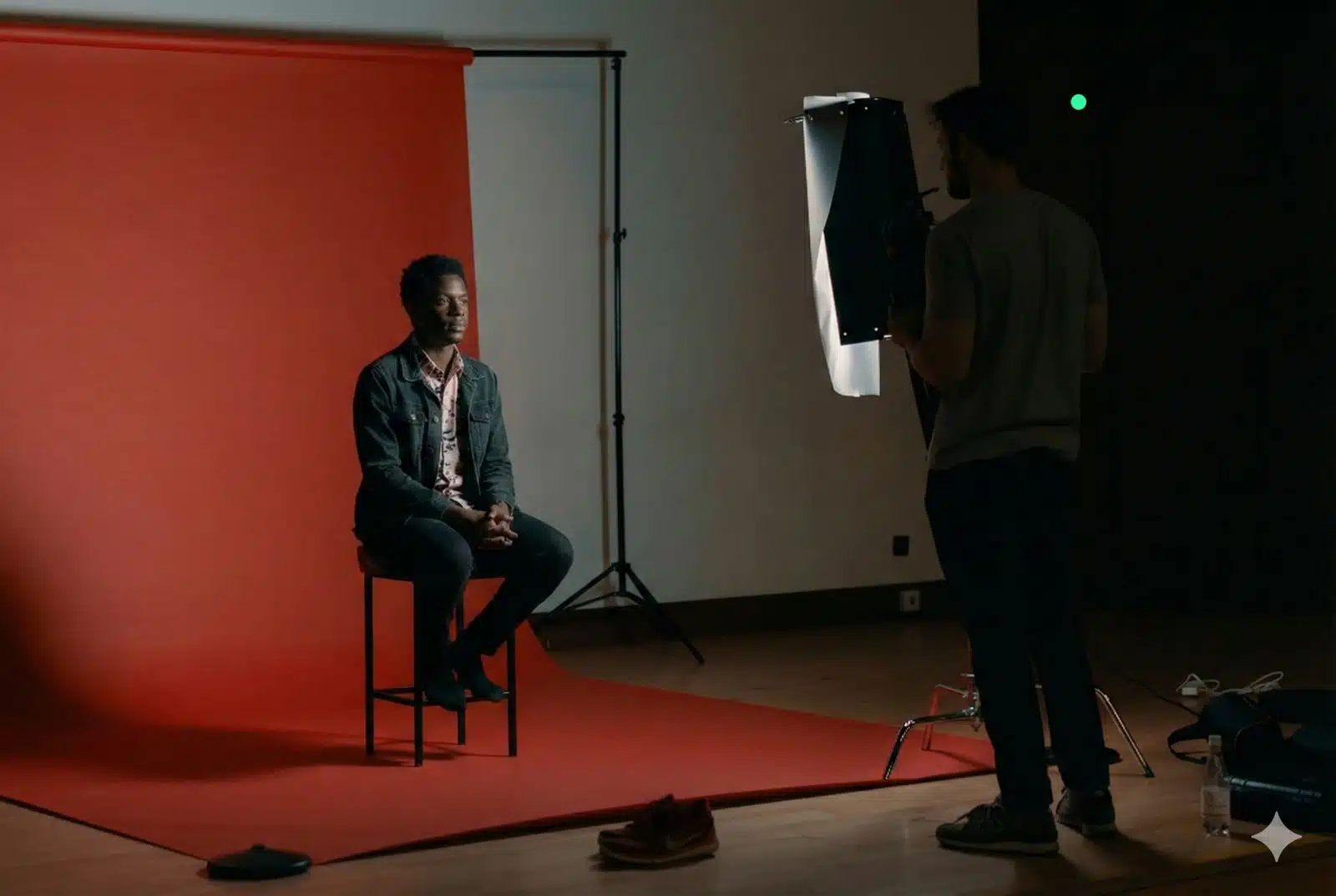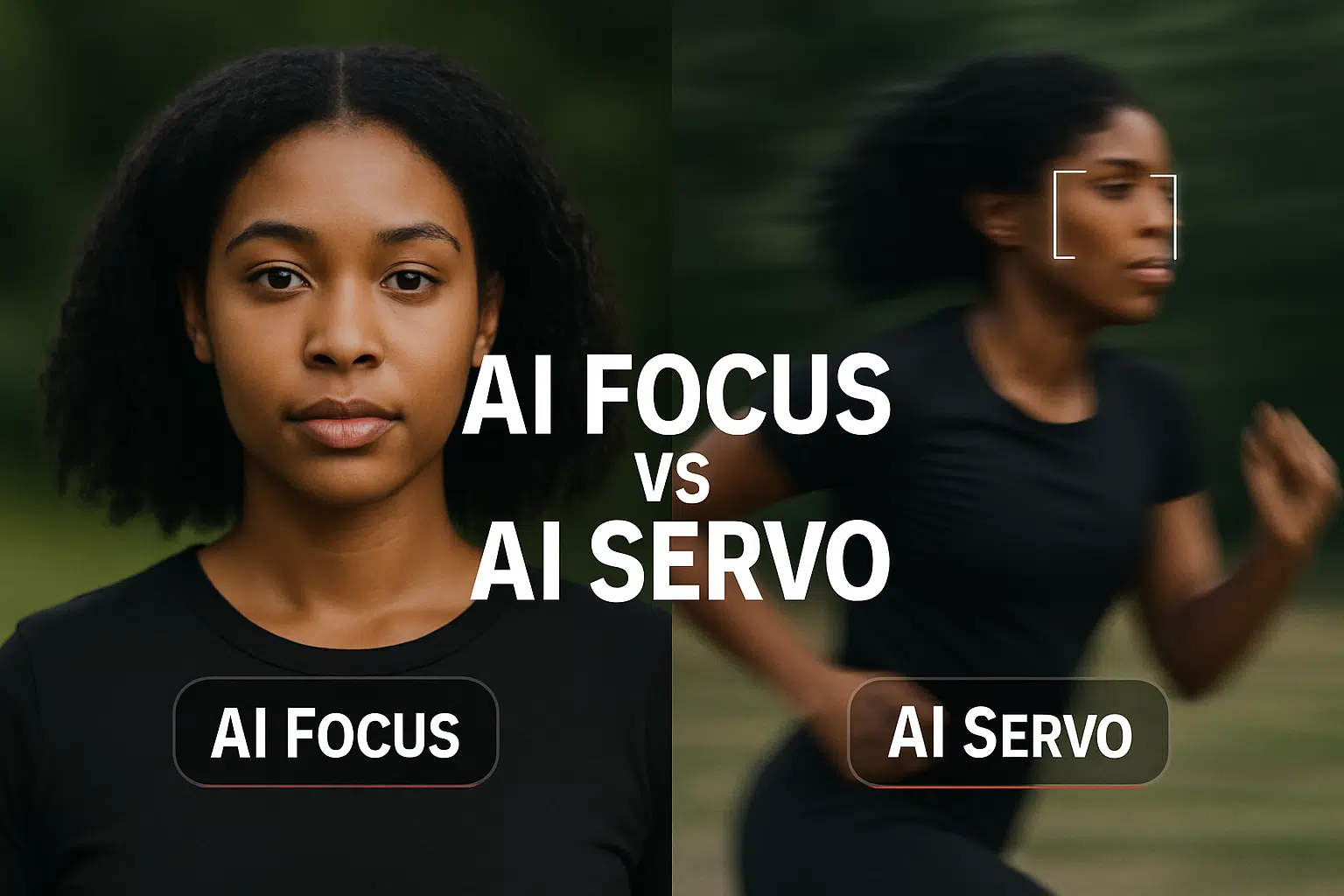
Photographs are taken in different situations.
No two shots share the same background story. Sometimes, the image is intentional; both the photographer and the subject know what’s coming. In other moments, only the photographer is present in that decision, capturing something spontaneous and unscripted.
That’s the core difference between AI Focus and AI Servo.
But there’s more to these auto modes than a three-line breakdown. In this article, you’ll learn how each one works, where each mode performs best, and how understanding their differences can sharpen your results behind the lens.
So before your next shoot, take a moment to learn the autofocus settings that can either elevate your photography or leave you with missed focus.
But before going straight to comparing AI Focus and AI Servo, let me introduce you to autofocus modes, their types (which in this case would be the Canon camera types), and why they matter in photography.
What Autofocus modes are, their types, and why they matter
Autofocus (AF) is the system your camera uses to make your subject appear sharp and clear. When you half-press the shutter button, the camera quickly measures the distance to your subject and adjusts the lens to focus. But because every scene is different (some subjects remain still while others move unpredictably), your camera needs flexible response methods. That’s the role of autofocus modes: they tell your camera how to behave based on the type of motion in your shot.
Most modern cameras include more than one AF mode, but Canon, a dominant brand across both DSLR and mirrorless systems, offers these three primary AF modes, each designed for a different kind of situation:
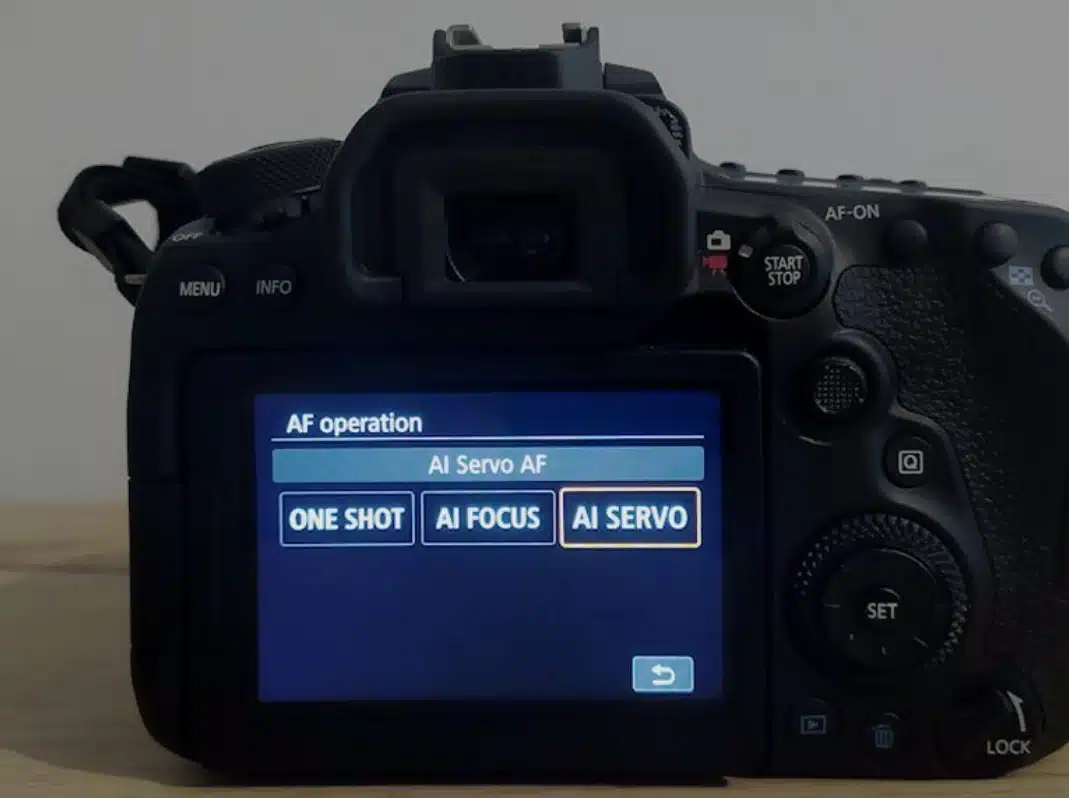
Source: Shotkit
One-Shot AF:
- Best for stationary subjects. The camera locks focus when you half-press the shutter and won’t readjust unless you release and refocus.
AI Servo AF:
- This is built for motion. Its focus mode keeps adjusting as long as the shutter button is held halfway, making it the right choice for constantly moving subjects.
AI Focus AF:
- This one is a hybrid. It starts like One-Shot AF, but automatically switches to AI Servo if the subject begins to move.
These modes aren’t just features but decision systems. They tell your camera how to behave based on what you’re photographing.
Choosing the correct AF mode saves you from missed shots and soft focus. It puts you in control of the outcome, even when your subject doesn’t cooperate.
The following sections will examine AI Focus and AI Servo, the two modes most often misunderstood and misused.
What is AI Focus?
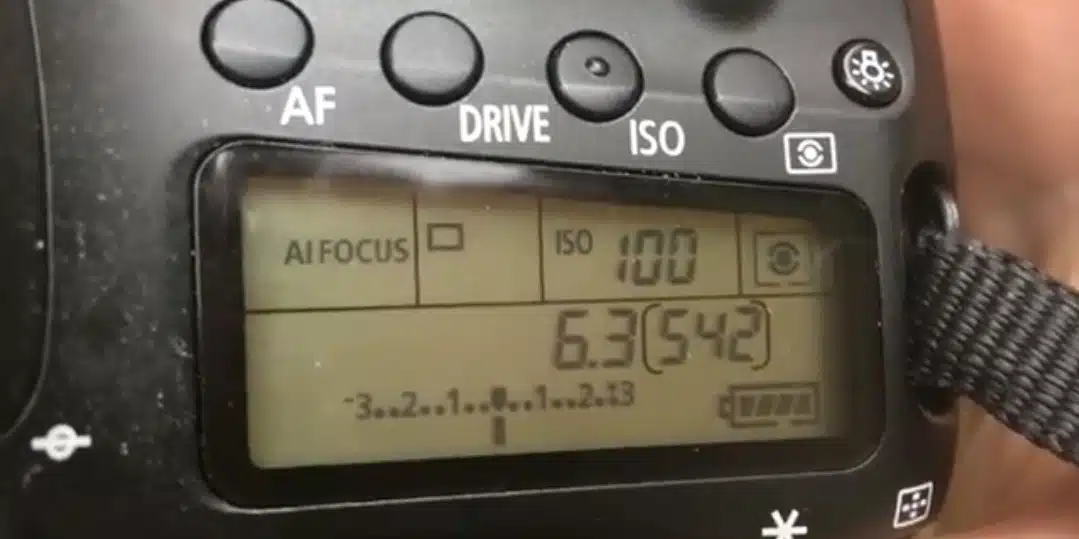
Source: YouTube
AI Focus AF is Canon’s autofocus mode, which automatically switches between focusing on still subjects and tracking moving ones. It combines the benefits of One-Shot AF (which locks focus on static subjects) and AI Servo AF (which continuously tracks moving subjects), giving you a system that tries to adapt depending on how your subject behaves.
But don’t be confused by the word “AI.” In this case, it doesn’t refer to complex machine learning. Instead, it’s a pre-programmed detection system that listens for movement and reacts based on a set of built-in rules.
How AI Focus works in real-life use (behind-the-scenes run-through)
Here’s a detailed breakdown of what happens when you use AI Focus:
When you half-press the shutter button in AI Focus mode, your camera initially behaves just like it would in One-Shot AF It analyzes the scene, locks focus on a still subject, and confirms that lock with a beep sound and the lighting of the focus indicator (< >) in the viewfinder.
However, suppose the subject begins to move (say, a person turns their head or a pet shifts position). In that case, the camera senses that change and immediately switches to AI Servo behavior, engaging continuous focus tracking without requiring you to lift your finger or manually change modes.
This adaptive switch from still to motion-tracking makes AI Focus particularly useful in dynamic environments, where it’s hard to predict whether your subject will remain still or start moving at any moment.
However, focus is no longer locked once the mode switches into Servo behavior. The camera begins to update focus continuously to track your subject’s motion. During this phase, the focus indicator stops lighting up, though the camera will issue a soft, continuous beep to signal it’s still working. Importantly, exposure in AI Focus is still set at the initial focus lock point, not during Servo tracking. This makes AI Focus less ideal for scenes with significant lighting changes after the subject begins to move.
When AI Focus performs well
- Portrait sessions with slight movement. AI Focus works well when capturing portraits where the subject occasionally shifts (maybe they tilt their head, lean slightly forward, or readjust their shoulders). It allows you to lock focus initially and catch the subject if they move subtly.
- When taking planned pictures of children or pets. Children and animals often start out still but suddenly move without warning. With AI Focus, you can begin in a One-Shot-style lock, and if they sprint off or shift positions, the system switches into tracking mode without you needing to adjust manually.
- When taking group photos, where someone may move, even a slight turn of the head or a quick hand gesture can throw focus off. AI Focus handles these light, unexpected adjustments smoothly by locking focus first and then shifting into tracking if one of your subjects starts to move.
- AI Focus is helpful when covering casual events like birthday parties or meetups. In dynamic, social settings where people alternate between standing still and walking around, it adapts as your subjects go from posed moments to spontaneous motion, making your work easier without constant mode switching.
- When shooting scenes with inconsistent or uncertain subject behavior. Whether it’s a person pausing to pose, walking away, or a pet lying still before jumping up, AI Focus bridges the gap. It’s the go-to choice when your subject’s behavior isn’t clearly defined as still or moving.
When AI Focus can let you down
- When tracking fast or erratic movement, subjects that change direction quickly, like sports players, racing pets, or birds taking flight, can confuse AI Focus. It may hesitate before switching to Servo mode, and that delay can result in soft or missed focus.
- When shooting high-action scenes like sports or wildlife. AI Focus isn’t built to address the urgency of action photography. It can miss critical moments if it doesn’t transition to continuous focus fast enough. In these cases, AI Servo should be your default.
- When you’re shooting in unpredictable lighting or contrast. Low light or backlit scenes can affect the camera’s ability to detect motion accurately. AI Focus might lock when it should track or switch unnecessarily, causing instability in focus.
- When you need consistent focus results every time. AI Focus’s automatic switching sounds helpful, but it’s inconsistent. Relying on the camera’s judgment introduces variables. For professional or time-sensitive shooting, that unpredictability can be a dealbreaker.
- When you’re using burst mode for continuous shooting. AI Focus doesn’t hold up well in burst mode. Since it wasn’t designed to proactively track motion from the beginning, you may lose sharpness across multiple frames if movement occurs mid-sequence.
Pros of AI Focus AF
- AI Focus automatically adapts to subject movement. It starts by locking focus, and if it detects the subject moving, it automatically switches to AI Servo. This flexibility is helpful in unpredictable shooting scenarios where motion isn’t guaranteed.
- It is suitable for casual and entry-level photography. AI Focus reduces decision-making if you’re not confident switching between autofocus modes manually. It acts as a safety net, especially for beginners or those who want to keep shooting simply.
- AI Focus is perfect for mixed-motion environments. In events like family gatherings, casual street shoots, or spontaneous portraits, it handles both stillness and motion without needing manual intervention.
- AI Focus reduces the need to pause and adjust settings. Instead of wasting time toggling between AF modes during a session, it allows continuous shooting across stillness and motion moments.
- It’s helpful for one-time, unpredictable subjects. When you’re unsure of how a subject might behave(like kids, pets, or candid moments), AI Focus offers a middle-ground solution with some built-in tracking ability.
Cons of AI Focus AF
- Slow or delayed response to motion. The biggest drawback is that AI Focus only reacts to movement and doesn’t anticipate it. This delay can cause you to miss sharp focus if your subject moves suddenly.
- Unreliable in fast-paced scenes. Because of the switching lag and its reliance on movement detection, AI Focus often underperforms in fast action photography like sports or wildlife tracking.
- You can switch it when you don’t want it to. AI Focus may misinterpret minor shifts as significant movement, unnecessarily switching to AI Servo and throwing off your intended composition or focus lock.
- It lacks control and predictability. Photographers who want complete control will find AI Focus limiting because they’ll keep going through a process of trusting the camera to make a decision, which it might not always get right.
- No consistent feedback. Once AI Focus switches to Servo mode, you lose the focus indicator in the viewfinder and get only a soft beep. That can make it harder to confirm focus mid-shoot, especially in noisy or chaotic environments.
Now let’s take a look at AI Servo AF.
What is AI Servo AF?
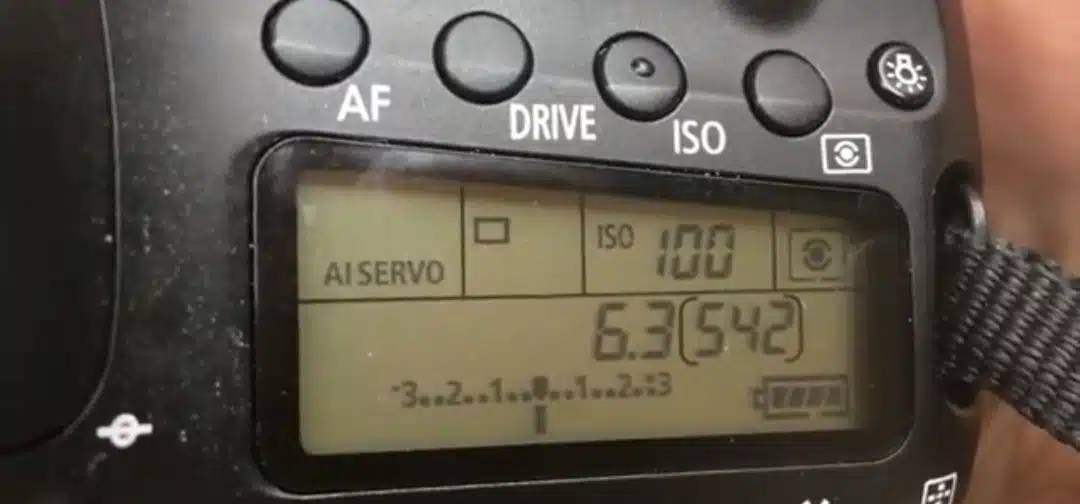
Source:; YouTube
In engineering, “Servo” describes a system that actively controls motion based on feedback.
AI Servo AF is Canon’s autofocus mode, explicitly designed for constantly moving subjects. Unlike One-Shot AF, which locks focus once, AI Servo AF keeps adjusting focus continuously as long as you hold the shutter button halfway.
Here’s how AI Servo behaves before it takes a shot in real-world use
When you half-press the shutter button, the system doesn’t simply lock and stop. Instead, AI Servo locks onto your subject and continues tracking it in real time, even if it speeds up, slows down, or changes direction. It constantly evaluates the distance between your lens and the subject and adjusts accordingly.
Let’s say you’re a photographer in a stadium holding a running contest, trying to get the first-place runner across your frame. From the second you engage AI Servo, the camera adapts continuously, predicting where the subject will be and making micro-adjustments to keep focus on the target frame by frame.
Now, what you won’t get is the usual confirmation feedback. There will be no audible beep telling you “focus achieved.” That’s by design; it prevents delays during continuous shooting. The viewfinder also has no blinking focus indicator (< >) like you’d expect in One-Shot AF. With AI Servo, you’re trusting the system to keep tracking even when there’s no visual cue to tell you it’s doing so.
AI Servo becomes even more effective in cameras equipped with 45 AF points or more. As long as your subject stays within the selected AF zone, the system will maintain focus even when it shifts around the frame.
What AI Servo requires to achieve a solid result is:
- Steady tracking. You need to keep the subject in the focus area (usually the center or selected zone).
- Practice. It takes a little getting used to, especially if you’re used to autofocus locking.
- Battery life. Because it’s always working, it uses a bit more battery life.
When AI Servo AF performs best
AI Servo AF excels when movement is consistent and expected and requires constant focus tracking from the first frame to the last. Below are real-world examples where this autofocus mode proves essential:
Sports and Action Photography. As the word implies, sport and action happen in continual movement. For example, footballers sprint toward the goal or leap for a header; in basketball, a player jumps to shoot or cut toward the basket; and martial artists give kicks in mid-air. AI Servo is built to capture these professionals in all these respective moments.
Dance Performances. Movement is fluid but unpredictable during choreographed routines (like ballet pirouettes or street dance flips). AI Servo can adjust focus in this event, following each twist and extension without falling behind.
Nature and Wildlife. AI Servo is perfect for photographing birds soaring overhead, deer trotting across a clearing, or monkeys swinging from tree to tree. Photographing wildlife in motion with AI Servo keeps the subject sharp no matter its direction.
Street Photography in Motion. AI Servo gives you the edge if you’re into documenting real-life moments on the move. Pinterest or Pixabay photos of people walking across intersections, vendors shifting through crowds, or bikers gliding past are achievable with AI Servo since its focus keeps up without delay.
Children and Pets at Play. While AI Focus can still get this done, the difference with AI Servo doing it lies in the volume of movement made by the children and pets. While the former is great for a sudden shift that lasts for, say, 3 seconds, it can’t focus on jumping, unaware picture-ready children dashing around a playground, or dogs running after a ball. AI Servo can keep them in focus through sudden starts, stops, and unpredictable sprints.
Motorsports and Racing. These activities involve cars tearing through a racetrack or bikes weaving between curves, and AI Servo can place steady focus on them even as speeds spike or vehicles change direction.
When AI Servo AF might fall off expectations
Despite its strengths, AI Servo has limitations, mainly when used in the following conditions:
- In the face of stationary or slightly moving subjects. Since AI Servo never fully locks focus, it may constantly readjust even when the subject barely shifts, causing soft or unstable focus.
- In low-light or low-contrast environments, dim indoor setups, hazy weather, or backlit subjects can make Servo hesitate or hunt, delaying capture.
- When the AF point is misplaced. If your chosen AF point drifts off your target, AI Servo can mistakenly track the wrong subject, such as the background or a nearby distraction.
AI Servo AF pros
- Continuous tracking. It constantly adjusts focus as long as the shutter button is half-pressed. This is perfect for fast-moving subjects that don’t have a known stop point.
- Real-time responsiveness. As your subject changes distance, AI Servo keeps up. This is perfect for unpredictable or high-speed motion, such as that of athletes or animals.
- You can shoot in burst mode. AI Servo excels at continuous shooting. It keeps refocusing between frames, keeping multiple shots sharp.
- No need for manual focus. You don’t have to lift a finger and refocus when your subject moves; the camera does everything in the background.
Essential for professional action photography, AI Servo is the industry standard for movement-heavy environments, from weddings to wildlife and sports.
AI Servo AF cons
- There is no focus confirmation. There is no beep or visual cue to tell you focus is locked, making it harder to tell if your subject is sharp, especially for beginners.
- Overcorrection on still subjects. If your subject stops moving, AI Servo keeps adjusting and may throw off focus unnecessarily.
- Poor performance in low light or low contrast. In dim scenes or flat lighting, it may “hunt” for focus or hesitate, resulting in missed shots.
- There are risks associated with AF point misalignment. If your chosen AF point drifts off the subject, the system may focus on the wrong thing, especially when shooting wide open or with a shallow depth of field.
Pro tip:
While discussing AI Focus and AI Servo, you’d have noticed recommendations on half-pressing the shutter button for maximum results. But another method that gives you more control is back-button focusing.
Instead of letting the shutter button handle both focus and capture, back button focusing assigns the focus function to a separate button on the back of your camera, often labeled AF-ON.
Here’s how it works:
- You press the AF-ON button with your thumb to focus.
- Then, you press the shutter button to take the shot without refocusing.
This method is helpful in several ways because:
- You gain more control over when and how focus is activated.
- You avoid accidentally refocusing when recomposing a shot.
- It enables continuous autofocus across One-Shot, AI Focus, and AI Servo modes.
- You can easily switch between automatic and manual focus without changing camera settings.
A detailed, side-by-side analysis of AI Focus vs AI Servo performance
When choosing between AI Focus AF and AI Servo AF autofocus modes on your camera, it’s crucial to understand precisely how each system operates, especially as modern autofocus performance can make or break your shot. Below is an exhaustively detailed breakdown to guide you in selecting the best mode for your shooting style, along with an expanded summary table.
Autofocus speed
AI Servo AF operates by continuously tracking a subject’s movement and adjusting focus in real time, offering no perceptible delay. This means the system remains locked on as soon as your subject moves, even ensuring you’re ready to capture sharp images at every instant. AI Servo’s continuous nature is particularly vital for action, wildlife, and sports scenarios, where even fractions of a second matter.
AI Focus AF, by contrast, starts in a single-shot (One-Shot AF) mode, achieving focus and locking it when the subject is still. It attempts to switch to AI Servo’s continuous tracking only when movement is detected. This “intelligent” switching introduces a short lag, which can represent just enough of a delay to miss fast-moving moments.
Winner: AI Servo AF, for its rapid, uninterrupted focusing on moving subjects.
Focus lock
AI Focus AF gives you an initial lock on a stationary subject. If that subject begins to move, though, the lock is automatically released, and the camera tries to track with Servo logic. This can be helpful for scenes where subjects could move unexpectedly, but there’s a risk the mode won’t always transition instantly.
AI Servo AF never truly locks onto one point. Instead, it adjusts focus continually, never “settling” on a single focal distance. You maintain dynamic focus control, which means the camera always attempts to keep up with your subject’s motion. However, some photographers note that it can sometimes cause the photographer to lose focus if a subject stops abruptly or another object obstructs the target.
Winner: Tie: AI Focus for initial static focus; AI Servo for continuous, fluid movement.
Accuracy
AI Servo AF excels at maintaining accuracy with fast or erratically moving subjects by employing predictive algorithms that anticipate subject motion. These systems analyze distance and motion patterns frame-by-frame, enabling cameras to stay locked on even with abrupt direction or speed changes. Many Canon bodies allow tuning parameters like tracking sensitivity for further refinement.
AI Focus AF is less reliable for unpredictable movement. How the detection and transition from static to continuous focus determine its performance. If switching is delayed or the system misjudges motion, critical moments can be lost or fall slightly out of focus.
Winner: AI Servo AF for its reliable, high-accuracy results with moving subjects.
Handling motion
AI Servo AF is expressly designed for continuous, high-speed motion: athletes, flying birds, vehicles, and similar subjects are tracked smoothly. Advanced algorithms in recent cameras reject errors caused by subjects exiting the autofocus area or being briefly blocked. AI Servo can even anticipate where the subject will be at the moment of capture, further optimizing focus under complex motion scenarios.

Credit: Ayşenur Sağlam (left) / Tim Mossholder (right
AI Focus AF works best when dealing with mild, unexpected movement, not persistent action. It can help if a subject is initially still but may move, but for anything dynamic from the outset, AI Servo is overwhelmingly superior.
Winner: AI Servo AF, especially for rapidly changing scenes.
Reliability
AI Servo AF grants the photographer control over AF point selection, area modes, and tracking sensitivity, leading to consistent, repeatable results as long as the user is familiar with the system. Its behavior doesn’t vary based on the camera’s evaluation. So what you set is what you get.
AI Focus AF relies on camera-driven automation, which may misjudge the right time to switch modes. This unpredictability can lead to missed shots or inconsistent results, particularly in demanding environments.
Winner: AI Servo AF, by consistent, user-guided performance.
User control
AI Servo AF empowers the photographer. You choose the focus area, adjust tracking response, and can use advanced features like back-button focus for maximum creative control. This is ideal for those who enjoy active engagement and precise tracking.
AI Focus AF is better suited for those who prefer to let the camera decide, as it controls switching modes and tracking initiation. While this can feel easier initially, it comes at the cost of fine-tuned adjustments and can frustrate users in fast-paced shooting.
Winner: AI Servo AF for control; AI Focus for automation.
Learning curve & ease of use
AI Focus AF is recommended for newcomers or for casual settings, since it eliminates much of the decision-making about focus modes. You can point and shoot without extra steps.
AI Servo AF demands a modest investment in learning. Understanding focus point selection, configuring tracking cases (acceleration, sensitivity), and techniques like back-button focus all require practice but yield far greater performance in demanding scenarios once mastered.
Winner: AI Focus AF for simplicity; AI Servo AF for advanced users.
Summary comparison table
| Factor | AI Focus AF | AI Servo AF |
| Autofocus Speed | Slower (mode switching delay on detected motion) | Fast and continuous; constantly tracking |
| Focus Lock | Locks on still subjects; unlocks for movement may delay | Never locks; always updating focus to movement |
| Accuracy | Moderate; inconsistent with sudden or erratic movement | Highly; predictive algorithms for fast, unpredictable motion |
| Movement Handling | Works best for still or mildly moving subjects | Designed for rapid, continuous, or erratic motion |
| Reliability | Automation can cause unpredictable results or missed transitions | Consistent, reliable tracking with user configuration |
| User Control | Automated, less manual input or customization possible | Complete manual control of AF point selection and tracking adjustments |
| Learning Curve / Ease | Beginner-friendly; intuitive automation | Steeper curve; mastery yields superior results, especially in action or wildlife |
| Application Examples | Family portraits, landscapes, stationary, or infrequently moving subjects | Sports, wildlife, events, anywhere subjects move unpredictably |
Rounding up, AI Focus vs AI Servo: Which one should you use?
Choosing between AI Focus and AI Servo comes down to two simple questions: Is my subject going to be in a state of movement, or is it still prone to shifting slightly?
If the answer to the first question is yes, then AI Servo is the more reliable option. It’s built for motion, so whether you’re shooting kids playing, pets running, people walking, or anything moving through your frame, AI Servo will track that motion and keep the focus sharp.
Also, if your answer to question 2 is yes, my subject will be completely still, but might shift slightly. AI Focus can work just fine. It behaves like One-Shot AF and locks focus once. The real purpose of AI Focus is to simplify decisions for beginners or casual users who aren’t sure if something might move. But its most significant downside is unpredictability since it tries to guess, and that guess isn’t always accurate or fast enough.
So, a simpler breakdown is:
- If your subject is still and might move slowly, AI Focus is okay.
- If your subject moves fast, AI Servo is better.
- If your subject is moving, AI Servo is best.
- If you’re just learning or using auto settings, AI Focus might feel easier, but remember its limitations.
Also, don’t be carried away by the “AI” label in AI Focus. It’s not intelligent in the modern AI sense. It follows basic rules and can’t truly learn or predict complex motion.
Pro tip
Many experienced photographers skip AI Focus entirely and use One-Shot for still scenes and AI Servo for anything involving motion. This is because it gives them complete control and removes the possibility of guesswork and the risk of losing a shot that could have been spectacular.
Frequently asked questions (FAQs) about AI Focus vs AI Servo
Can I use AI Servo for still subjects, or is that a bad idea?
- You can, but it’s not the best choice. AI Servo doesn’t lock focus. Even if your subject stays still, the camera keeps adjusting, which can cause slight shifts or missed sharpness. For completely stationary subjects, One-Shot AF gives cleaner, more reliable results.
Does AI Focus drain more battery than other AF modes?
- Not significantly. However, when AI Focus switches between One-Shot and Servo due to subject movement, it can activate the autofocus system more frequently. AI Servo may still draw more power in high-action or unpredictable scenarios, especially in continuous shooting.
Is AI Focus available on all Canon cameras?
- No. Some of Canon’s newer mirrorless cameras have removed AI Focus entirely. These models focus on One-Shot and AI Servo modes instead, giving users more direct control. The change reflects Canon’s push toward more intentional, professional-level shooting behavior.
Why don’t professionals recommend AI Focus?
- Because it removes decision-making from the photographer. AI Focus relies on the camera to judge when a subject is moving. That delay can cost you sharpness in fast-paced moments. Professionals prefer the consistency of manually choosing between One-Shot and AI Servo.
Can AI Focus be used in burst shooting?
- It can, but it’s risky. If your subject starts still and then moves mid-burst, AI Focus may hesitate to switch modes fast enough. That can leave you with inconsistent focus across frames. AI Servo handles burst mode far more reliably from start to finish.
Does AI Servo work the same on mirrorless and DSLR cameras?
- Not exactly. Mirrorless Canon cameras often use sensor-based focusing systems like Dual Pixel CMOS AF, which offer smoother, faster performance in AI Servo. DSLRs rely on dedicated AF sensors, which may perform differently under certain lighting or composition conditions.
Can I use AI Servo with face or eye tracking?
- Yes, but only if your camera supports it. Canon’s advanced mirrorless models allow AI Servo to work alongside face and eye detection. This helps maintain accurate focus on moving subjects, especially during video or portrait sequences. Most DSLRs lack this feature.
Which autofocus mode is best for beginners?
- AI Focus is designed for beginners. It offers automation by switching modes as needed, which works in casual situations. But for real growth, beginners should learn to switch between One-Shot and AI Servo. That habit builds control and improves results.
Why doesn’t AI Servo give a beep when focus is locked?
- Because focus is never locked. AI Servo tracks constantly, so there’s no confirmation beep like with One-Shot AF. You’re expected to trust the system and visually confirm focus through the viewfinder or screen as your subject moves.
What’s the biggest mistake people make with AI, servo?
- They let their focus point drift off the subject. The AI Servo follows whatever is under the active AF point. If it slips away from your subject, the camera may track the wrong thing. You need to keep your AF point steady and deliberate throughout the motion.




